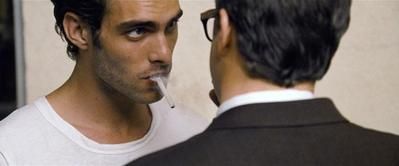
A Single Man can be described by one simple word: beautiful. We discussed this in class more than once, specifically that the frames are almost too beautiful. For me there is no argument on this point. This movie focused on making even the slightest of aspects within the frame so aesthetically pleasing that your eyes were more entranced by the images than the story. Moreover, each singular figure seemed to carry a weight that could not be thoroughly expressed in words. Although there was a million and one little details to chose from which your eyes can be captured, I found myself extremely drawn to something that wouldn’t necessarily be most people these days would consider disgusting: the cigarettes.
I am still not completely sure why I was drawn to them, or even why they carry much importance. However, the use of cigarettes by Tom Ford did not just seem like a choice to place the characters within a time period, but something more. When I first saw them, the act of lighting and inhaling is slowed down to give it a connection more so to the lips than the actual cigarette itself. Although we see many of the characters smoking through the entirety of the movie, we are never shown them actually finishing one. Instead they are thrown aside almost as quickly as they are lit. Being a former smoker of cigarettes myself, I know that this, at least nowadays, would seem like an extreme waste. Maybe it with the change in time, there has been a change in perspective of the actual smoker. However, it still just didn’t feel right.
As I realized this upon further inquiry, I took this use of cigarettes a step further. This whole movie is based on the ephemeral moments of life, capturing them rather than throwing them away. In a way these cigarettes are a physical representation of an fleeting moment. Not one regard is made when lighting a cigarette and almost immediately discarding it, much like the moments that George had taken for granted until that day in the movie. For me, the slowing down of the lighting and inhaling of the cigarette was done for the same reason that George began to take notice of small moments in life: because they are fleeting. The cigarette embodied these moments within the diegesis. Once I came to this conclusion I began to consider that not only is their physical nature a representation of the small moments, but it is also a representation of death more commonly. Through this line of thought, I came across to my own conclusion that the cigarette represents the short moment at which both Jim and George die, which is beautifully short, yet tragic. Also because their deaths are aestheticized, so is the cigarette throughout the movie.


